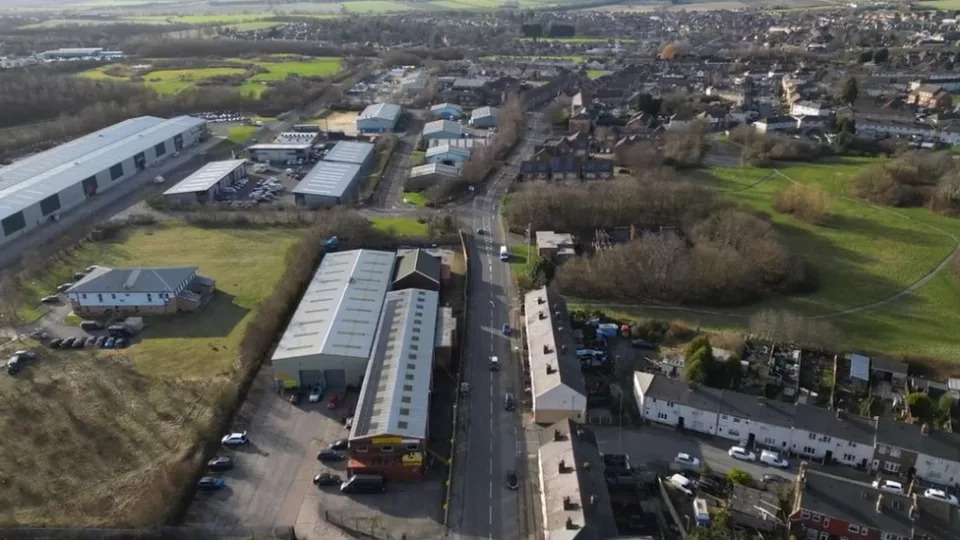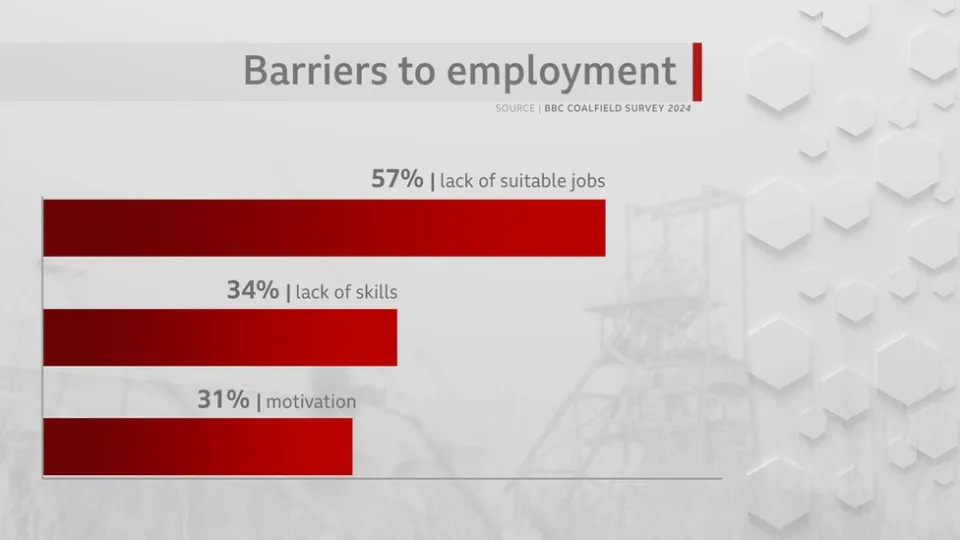
 



.gif)






|
Signature Sponsor


March 5, 2024 - In the UK, former coal-mining areas are falling further behind the rest of Britain decades on from pit closures, a charity has warned.
Forty years after the 1984 miners' strike, the Coalfields Regeneration Trust (CRT) said communities had been "let down" by a lack of investment since the loss of an industry which employed more than 220,000 people.
It comes as a survey commissioned by the BBC suggested 73% of people living in former mining towns and villages felt they had seen little or no progress on levelling up - the Conservatives' flagship policy aimed at reducing regional inequalities.
The government said it had committed £15bn to improve the lives of "everyone, everywhere in the UK" through levelling-up projects.
The BBC's poll of 2,426 people in former coalfield communities in England, Wales and Scotland found 57% felt there was a lack of suitable jobs in their area. Darren Wood, 49, who lives in the ex-mining village of Goldthorpe, near Barnsley in South Yorkshire, said he had been looking for work for five years but "never hears anything back" about his applications.
"You can apply for stuff, check your emails and you don't get any replies. They don't get back to you, not even a 'no, sorry you're not suitable or been successful'. It does grind you down," said the single father-of-two.
Thousands of men in Goldthorpe and neighbouring village Thurnscoe worked at four local collieries when miners across Britain went on strike in 1984 to fight the National Coal Board's plans to shut pits. By the end of 1994, all four mines - along with more than 120 others in England, Scotland and Wales - had closed. Linda McAvan, chair of the CRT, said: "The strike was 40 years ago but of course that was the beginning of the issues in the coalfields, not the end of them. "In that time some things have got better - land has been cleared up compared to how it used to be - but we see the gap widening between the coalfields and the other parts of the UK, the cities in particular." Job availability, growth in employment, the number of people with qualifications and wages in coalfield areas all lag behind the national average, previous research has found. A 2019 report by Sheffield Hallam University found there were 55 jobs per 100 residents in former mining areas, compared to a national average of 73. In London, there were 86 jobs for every 100 people. Health problems were also more widespread and life expectancy was lower in former mining towns, researchers found. 'Still playing catch-up'Levelling-up policies were a key part of the Conservative Party's campaign in the 2019 general election, when the party won seats from Labour in former coalfield areas such as Rotherham, Northumberland and North Wales. But the results of Survation's poll for the BBC suggested many people in coalfield communities still felt left behind. Only 16% of respondents said there had been progress on levelling up their area. The survey polled adults aged 18 to 64 in former mining heartlands across Britain, from Fife in Scotland to Dover in Kent. It found:
"Mining communities are still playing catch-up," said Sir Steve Houghton, leader of Barnsley Council. "The damage that was done - the economic as well as the social damage - was huge," he added. "That takes generations to pull back."
Around 20,000 jobs were lost in Barnsley when coal mines shut in the 1980s and 1990s. Warehouses and call centres - some built on the site of demolished collieries - have brought new jobs to the town. But the CRT, which works to improve quality of life in former coalfield areas across Britain, said many new roles were low-paying positions on flexible contracts that did not offer job security. Ms McAvan said there were "simply not enough jobs in the coalfields," forcing young people to commute elsewhere. "If our transport links were fantastic and cheap that might be OK, but they're not," she said.
Anna Lowe, 22, grew up in Thurnscoe and left school with few qualifications. She landed her first job two years ago at a warehouse in Manvers. "It was a big moment for me," she told the BBC. Ms Lowe lives with her parents and travels to work by bus. But by the time her shift finishes at 22:00, services have stopped for the day. Her choice is a four-mile walk home at night or a taxi. "I'm getting taxis back which is costing me about £12 a night just to get home," she said. "But I would much rather pay that than walk from Manvers to Thurnscoe. You've got to do what you've got to do."
Last year Barnsley Council established an independent commission aimed at identifying and removing barriers to employment. While the town's official unemployment rate of 3% is lower than the national average of 3.8%, more than a quarter of Barnsley's population is classed as economically inactive - meaning they are not employed and not actively seeking work. The national rate of economic inactivity is 21%, according to the Office for National Statistics. A Centre for Cities report last year said many men in former mining areas such as Barnsley and Sunderland "withdrew into economic inactivity" rather than registering unemployed when the coal industry collapsed. It said this "legacy of the 1980s" was "still visible on today's labour market". When you rename a whole government department with one of your slogans, you know you'd best make it work. The Department for Levelling Up, Housing and Communities took its new name straight from the manifesto promise that convinced many here to vote Conservative, often for the first time. In former pit villages the blue side of politics was a dirty word - but after years of feeling forgotten, voters changed their minds. Don't underestimate how big a shock it was for people to see places like Rotherham and Doncaster vote for the Conservatives. Much of that was down to Boris Johnson's levelling up promises. Conservative MPs attempting to keep their two-letter suffix this year will lean heavily on the pots of money given out as part of the Levelling Up and Towns Funds. They will point to that and say the money will be used to improve local towns and villages - but it is also offset by the huge cuts over the last 10 years to local councils. If people in former mining areas think they've not been "levelled up" then they'll tell you about it. The real survey happens later this year when they get to choose their MP. Thurnscoe charity Station House was once a soup kitchen which fed miners and their families during the strike. Today it helps parents stay in work by offering heavily subsidised childcare. Charlotte Williams, the charity's chief executive, said: "To live in Thurnscoe is a great experience, but it has its challenges. These challenges aren't always caused by the people who live here. "Poverty, transport, access to healthcare, access to employment, and at times it does tipple into anti-social behaviour and some of the other things we associate with poverty. But what we need to remember is nobody made themselves poor here. It's by circumstance."
The government said it was investing more than £320m in South Yorkshire, including improvements to high streets, transport, community hubs and residential areas. Barnsley Council has approved five projects which it said would "revitalise" Thurnscoe, Goldthorpe and neighbouring village Bolton upon Dearne using £23.1m of government funding. The first of those projects, a new public square in Goldthorpe, opened in October. But other coalfield areas have missed out on funding. Last year Wakefield Council in West Yorkshire said it was "extremely disappointed" the government had rejected its bid for £19m of levelling-up funding which it said would have "transformed" the former mining town of Knottingley. The town was once home to thousands of miners who worked at Kellingley Colliery, which was Britain's last operational pit when it closed in 2015 and was once the largest deep coal mine in Europe. The council had planned to use the money to build new leisure facilities and cycle lanes in Knottingley, where rates of ill health are higher than the national average. John Williamson, 65, worked as a courier in Knottingley for 16 years before suffering two strokes in 2018. He said: "I came home from work one day, not well. Went to the doctors, blood pressure through the roof. He says come back next week and we'll check it. I had two strokes the next morning sat in the bath." Mr Williamson was able to ease off his painkillers after enrolling on a course run by the CRT for people in chronic pain. But he said: "I can't work any more and it's done my head in." More than a third of people in coalfield areas suffer chronic health problems, according to the charity. 'Supporting everyone'Ms McAvan called for the government to implement a long-term strategy with specific targeted policies for coalfields. She added: "We don't want to be here in 25 years telling the same story. We want these communities to get the jobs, to grow their own wealth-building capacity, and to see people living decent lives here." A Department for Levelling Up, Housing and Communities spokesperson said: "We're supporting everyone, everywhere in the UK - including those in former coalfield communities - to improve their everyday lives through our £15bn levelling up programmes. "This includes our £1.1bn Long-Term Plan for Towns so local people are empowered to steer their town's regeneration over the next 10 years. Through this initiative, 55 towns, including former mining towns like Accrington, Burnley, Merthyr Tydfil and Chesterfield, will develop Long-Term Plans for regeneration based on local priorities to support transformation projects." |
 











|




